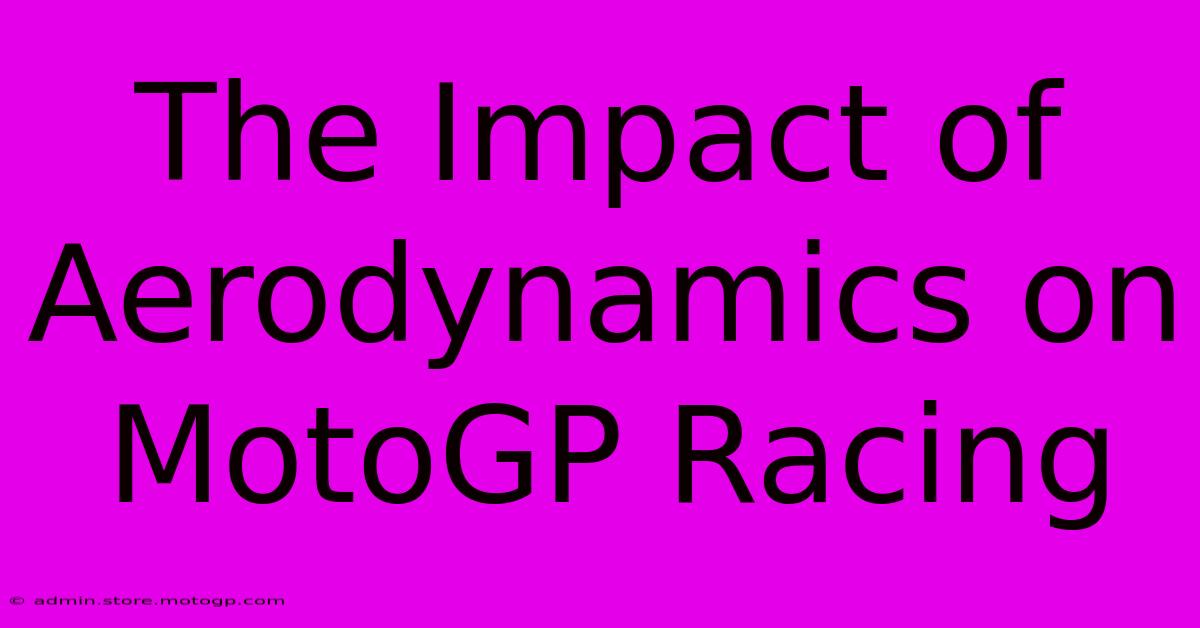The Impact Of Aerodynamics On MotoGP Racing

Table of Contents
The Impact of Aerodynamics on MotoGP Racing
MotoGP, the pinnacle of motorcycle road racing, is a relentless battle of speed, skill, and technology. While rider talent is paramount, the role of aerodynamics in achieving competitive edge cannot be overstated. Modern MotoGP bikes are incredibly sophisticated machines, and understanding the impact of airflow on their performance is crucial to unlocking their full potential. This article delves into the critical influence of aerodynamics on MotoGP racing, exploring its impact on speed, stability, and overall race performance.
Aerodynamics: The Unsung Hero of MotoGP Speed
Aerodynamics plays a pivotal role in maximizing a MotoGP bike's top speed and straight-line performance. The design of fairings, wings, and other aerodynamic components is meticulously engineered to reduce drag and improve downforce.
Reducing Drag: The Pursuit of Speed
Drag is the resistance a bike experiences as it moves through the air. Minimizing drag is crucial for achieving higher top speeds. MotoGP engineers employ various techniques to reduce drag, including:
- Streamlined Fairings: The fairings are sculpted to minimize air resistance, creating a smooth flow of air around the bike. Even small imperfections can significantly impact overall drag.
- Optimized Bodywork: Every component, from the fuel tank to the tail section, is designed to contribute to a streamlined profile, minimizing turbulence and maximizing aerodynamic efficiency.
- Computational Fluid Dynamics (CFD): Advanced simulations using CFD help engineers optimize the shape and design of the bike's bodywork, allowing for precise adjustments to reduce drag.
Generating Downforce: Cornering Mastery
Downforce is the force that pushes the bike down onto the track, increasing grip and stability, especially when cornering at high speeds. Modern MotoGP bikes utilize winglets and aerodynamic appendages to generate downforce.
- Winglets and Aerodynamic Appurtenances: These strategically placed wings create a downward force, preventing the bike from lifting off the track at high speeds, allowing for increased cornering speeds and stability.
- The Importance of Balance: The precise placement and angle of these aerodynamic elements are crucial for maintaining balance and preventing unwanted instability.
Beyond Speed: Aerodynamics and Race Performance
The impact of aerodynamics extends beyond simply achieving high speeds. It significantly influences several other critical aspects of racing:
Enhanced Stability and Control
The downforce generated by aerodynamic components significantly enhances the bike's stability, particularly during aggressive cornering and braking maneuvers. This improved stability allows riders to push the limits harder and maintain greater control, leading to faster lap times.
Improved Braking Performance
By increasing downforce, aerodynamics contributes to improved braking performance. The increased grip provided by the downforce allows the rider to brake later and harder, further reducing lap times.
Overtaking Maneuvers
Aerodynamics plays a crucial role in overtaking. Bikes with superior aerodynamic performance can maintain speed more effectively through corners, providing a decisive advantage when attempting to overtake rivals.
Race Strategy and Tire Management
The choice of aerodynamic setup also impacts race strategy. A setup prioritizing downforce might be favored for tracks with many high-speed corners, while a lower-drag setup might be preferred for tracks with long straights. Aerodynamic considerations also influence tire wear and management.
The Ever-Evolving Landscape of MotoGP Aerodynamics
Aerodynamic development in MotoGP is a continuous process. Teams are constantly experimenting with new designs and technologies to gain even the smallest of advantages. This constant innovation ensures the sport remains at the forefront of motorsport technology.
In Conclusion:
Aerodynamics is not merely a supporting player in MotoGP; it is a critical factor determining the outcome of races. From maximizing speed to enhancing stability and control, the intricate interplay of air and machine is essential for success at the highest level of motorcycle racing. The ongoing evolution of aerodynamic technology ensures the sport continues to push the boundaries of performance, captivating fans and driving technological advancement.

Thank you for visiting our website wich cover about The Impact Of Aerodynamics On MotoGP Racing. We hope the information provided has been useful to you. Feel free to contact us if you have any questions or need further assistance. See you next time and dont miss to bookmark.
Featured Posts
-
Find Your Way Around Cota The Formula 1 Austin Map
Feb 18, 2025
-
Cota Parking Secrets Revealed Find Your Perfect Spot
Feb 18, 2025
-
F1 Parking Pass Your Gateway To The Race
Feb 18, 2025
-
Racing Fan Must Haves Cota F1 Merchandise
Feb 18, 2025
-
F1 Starting Grid More Than Just Pole Position
Feb 18, 2025
